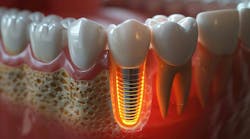Water fluoridation is often touted as one of the great public health successes of the 20th century, celebrated for reducing dental decay and saving billions in dental costs.1 It’s widely accepted that adding fluoride to water prevents tooth decay, with studies showing around a 25% reduction in cavities among those who drink fluoridated water—a lifeline for those without access to regular dental care.2
Yet in recent years, fluoride’s standing as a public health hero has faced increasing scrutiny. Research on potential links between fluoride and developmental issues in children, particularly brain development, has led to legal challenges and renewed calls for regulation. With fluoride in the water of more than 70% of US communities, the debate is no longer a trickle; it’s a flood.3
Let’s take a step back and ask, “Is fluoride's effectiveness as a cavity fighter enough to outweigh the potential concerns?”
The long-held belief challenged
There’s no denying that fluoride works. Since its adoption in the 1940s, water fluoridation has drastically reduced the prevalence of cavities.2,3 For communities, particularly those with limited access to dental care, fluoridated water has acted as a safeguard against a rise in dental disease.
Economically, the benefits are clear. A Colorado study found fluoridation saved $6.8 billion in dental costs in a single year.4 And the CDC claims communities save about $32 per person annually due to reduced dental treatment costs.5 For rural and underserved populations, fluoride’s preventive power may be the only barrier between them and severe dental disease.
The troubling question: At what cost?
However, new research is raising uncomfortable questions about fluoride’s safety, particularly for children. A National Toxicology Program review cited a link between high fluoride exposure and reduced IQ in children, prompting a federal judge to order the EPA to reconsider fluoride regulations.6 Judge Edward Chen’s ruling was based on years of data, which, he argued, justified closer scrutiny of fluoride’s potential neurological impacts.
The concern is that fluoride, while beneficial to teeth, may not be as benign in other parts of the body. Some scientists suggest that fluoride can cross the blood-brain barrier, potentially accumulating in the brain and affecting cognitive development.7-10 Studies have found an association between high fluoride exposure and IQ reduction in boys, while other research has indicated that fluoride can impact the thyroid and bone density.11-13 Fluoride’s antimicrobial nature might also disturb the microbiome and affect overall health.14
This raises a critical question for dental professionals, “Is it fair to push for fluoridation without fully understanding its long-term impact on other systems?”
The autonomy argument
In some places, the question of fluoridation has become as much a matter of autonomy as it is of public health. In Hawaii, which has long resisted water fluoridation, some proponents argue that each community should have the right to decide what goes into its water, especially if there are lingering questions about safety.
Municipalities that have opted out of fluoridation often find themselves with higher rates of decay. Hawaii has some of the nation’s highest rates of tooth decay in children.15 But could fluoride’s cumulative exposure, from both natural sources and fluoridated products, mean it’s no longer just a public health solution but a potential health risk in and of itself?
Rethinking preventive care
For now, water fluoridation remains an essential preventive measure for millions. However, should the research continue to highlight risks, dental professionals will need to advocate for alternative approaches to preventive care.
If fluoride were removed, the impact would be profound, particularly on children, the elderly, and underserved communities. Preventing an uptick in caries and dental infections would require collaborative efforts.16 Dental associations would need to lead the charge for affordable dental care access, promote regular preventive visits, and support families in adopting better oral hygiene habits at home. Investments in access to care, especially in rural areas, would be paramount.
What alternatives to fluoridated water might look like
Fluoride varnishes and topical applications: Instead of community-wide fluoridation, professionals could advocate for more personalized fluoride treatments through varnishes, mouth rinses, and toothpastes.
Hydroxyapatite products: This naturally occurring mineral in teeth can help prevent cavities and could become more prevalent as a fluoride alternative, allowing for a different approach to strengthening enamel.17,18
Water filtration choices: Patients concerned about fluoride can take control of their exposure with filters designed to remove fluoride from drinking water, such as reverse osmosis systems.19,20
A balancing act for public health
Dental professionals are at the intersection of science and patient advocacy. While fluoride has undeniably made an impact on oral health, it’s crucial to stay informed about the evolving research and consider its broader health implications.
Ultimately, the debate over fluoride is not just about public health. It’s about respect for community choices, transparency in science, and an evolving understanding of what it means to protect health in a holistic sense. The task now is to ensure that our practices align with the best available evidence, advocating not only for tooth health but for the well-being of every person in the communities we serve.
Water fluoridation has built an impressive legacy, but perhaps it’s time to explore its role in a future that considers not just dental health, but comprehensive, whole-body health as well. As research advances, we may find ourselves championing new, innovative solutions that challenge our traditional methods, and that’s progress worth fighting for.
References
1. Ten great public health achievements – United States, 1900-1999. April 2, 1999. https://www.cdc.gov/mmwr/preview/mmwrhtml/00056796.htm
2. Achievements in public health, 1900-1999: Fluoridation of drinking water to prevent dental caries. October 22, 1999. https://www.cdc.gov/mmwr/preview/mmwrhtml/mm4841a1.htm
3. Hung M, Mohajeri A, Chiang J, Park J, Bautista B, Hardy C, Lipsky MS. Community water fluoridation in focus: a comprehensive look at fluoridation levels across America. Int J Environment Res Public Health. 2023;20(23):7100. doi:10.3390/ijerph20237100
4. Gill N. Water fluoridation saves Americans over $6 billion in dental work. The University of Colorado Anschutz Medical Campus News. July 30, 2019. https://news.cuanschutz.edu/news-stories/water-fluoridation-saves-americans-over-6-billion-in-dental-work
5. O’Connell J, Rockell J, Ouellet J, Tomar SL, Maas W. Costs and savings associated with community water fluoridation in the United States. Health Affairs. 2016;35(12):2224-2232. doi:10.1377/hlthaff.2016.0881
6. NTP monograph on the state of the science concerning fluoride exposure and neurodevelopment and cognition: a systematic review. National Toxicology Program August 2024. https://ntp.niehs.nih.gov/sites/default/files/2024-08/fluoride_final_508.pdf
7. Guth S, Hüser S, Roth A, et al. Toxicity of fluoride: critical evaluation of evidence for human developmental neurotoxicity in epidemiological studies, animal experiments and in vitro analyses. Archives of Toxicology. 2020;94(5):1375-1415. doi:10.1007/s00204-020-02725-2
8. Fluoride and brain: a review. International Journal of Pharmaceutical Sciences and Research. Updated May 21, 2020. https://ijpsr.com/bft-article/fluoride-and-brain-a-review/ https://www.researchgate.net/profile/Debosree-Ghosh/publication/338571261_Flouride_and_Brain_A_Review/links/5ec675c1299bf1c09acfc876/Flouride-and-Brain-A-Review.pdf
9. Grandjean P. Developmental fluoride neurotoxicity: an updated review. Environmental Health. 2019;18(1). doi:10.1186/s12940-019-0551-x
10. Żwierełło W, Maruszewska A, Skórka-Majewicz M, Gutowska I. Fluoride in the central nervous system and its potential influence on the development and invasiveness of brain tumours—a research hypothesis. Int J Molec Sci. 2023;24(2):558. doi:10.3390/ijms24021558
11. Iamandii I, De Pasquale L, Edvige Giannone M, et al. Does fluoride exposure affect thyroid function? A systematic review and dose-response meta-analysis. Environment Res. 2023;117759-117759. doi:10.1016/j.envres.2023.117759
12. Levy S, Warren J, Phipps K, et al. Effects of life-long fluoride intake on bone measures of adolescents. J Dent Res. 2014;93(4):353-359. doi:10.1177/0022034514520708
13. Everett E. Fluoride’s effects on the formation of teeth and bones, and the influence of genetics. J Dent Res. 2010;90(5):552-560. doi:10.1177/0022034510384626
14. Moran GP, Zgaga L, Daly B, Harding M, Montgomery T. Does fluoride exposure impact on the human microbiome? Toxicology Letters. 2023;379:11-19. doi:10.1016/j.toxlet.2023.03.001
15. Hawaii Smiles 2015. The oral health of Hawaii’s children. 2016. https://health.hawaii.gov/about/files/2013/06/Hawaii-Smiles-Report.pdf
16. CDC scientific statement on community water fluoridation. Centers for Disease Control and Prevention. September 12, 2024. https://www.cdc.gov/fluoridation/about/statement-on-the-evidence-supporting-the-safety-and-effectiveness-of-community-water-fluoridation.html#
17. Paszynska E, Pawinska M, Enax J, et al. Caries-preventing effect of a hydroxyapatite-toothpaste in adults: a 18-month double-blinded randomized clinical trial. Frontiers in Public Health. 2023;8(11):1199728. doi:10.3389/fpubh.2023.1199728
18. O'Hagan-Wong K, Enax J, Meyer F, Ganss B. The use of hydroxyapatite toothpaste to prevent dental caries. Odontology. 2022;110(2):223-230. doi:10.1007/s10266-021-00675-4
19. Khairnar MR, Jain VM, Wadgave U, et al. Effect of different reverse osmosis water filters on fluoride content of drinking water. J Ind Assn Public Health Dent. 2018;16(2):165-168. doi:10.4103/jiaphd.jiaphd_8_18
20. Jaafari-Ashkavandi Z, Kheirmand M. Effect of home-used water purifier on fluoride concentration of drinking water in southern Iran. Dent Res J. 2013;10(4):489-492. https://pmc.ncbi.nlm.nih.gov/articles/PMC3793412/
About the Author

Brittany Cox, MA, RDH
Brittany Cox, MA, RDH, is a sustainable systems strategist and policy architect guiding health care toward a planet-first future. With a background in oral health promotion, leadership, and coaching, she helps dental practices and institutions cut waste, improve care, and operate more sustainably. Now studying environmental and health law, she’s expanding her impact through policy. Known for turning complex challenges into clear strategy, Brittany empowers leaders to do better by their patients, people, and the planet. Brittany can be reached at [email protected].


